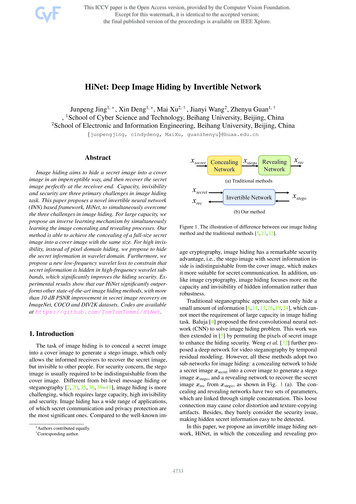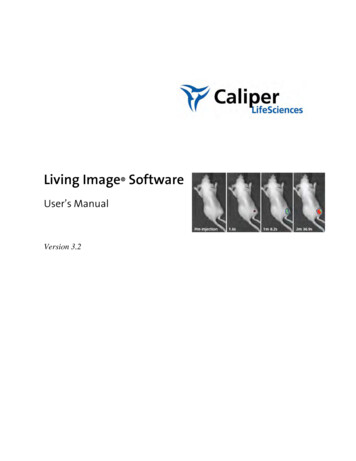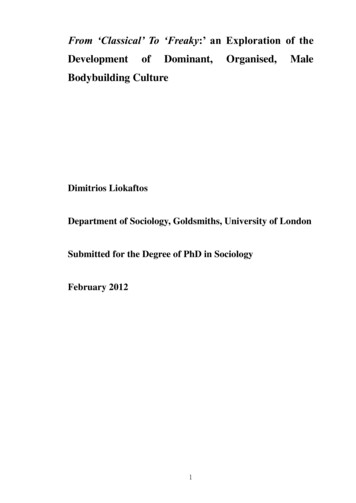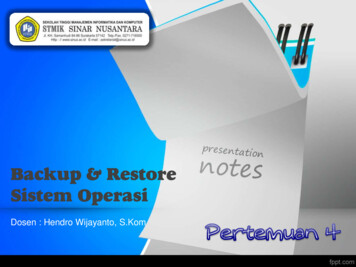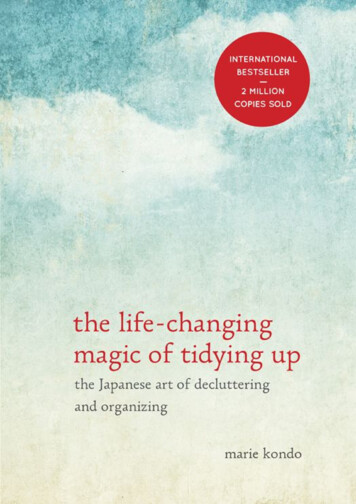
Transcription
Copyright 2014 by Marie KondoAll rights reserved.Published in the United States by Ten Speed Press, an imprint of the CrownPublishing Group, a division of Random House LLC, a Penguin RandomHouse Company, New York.www.crownpublishing.comwww.tenspeed.comTen Speed Press and the Ten Speed Press colophon are registeredtrademarks of Random House LLC.Originally published in Japan as Jinsei Ga Tokimeku Katazuke No Maho bySunmark Publishing, Inc., Tokyo, in 2011. Copyright 2011 by MarieKondo. English translation rights arranged with Sunmark Publishing, Inc.,through InterRights, Inc., Tokyo, Japan, and Waterside Productions Inc.,California, USA. This English translation by Cathy Hirano rst published inGreat Britain by Ebury Publishing, an imprint of Random House UK,London.Library of Congress Cataloging-in-Publication DataKondo, Marie, author.[Jinsei ga tokimeku katazuke no maho. English]The life-changing magic of tidying up : the Japanese art of decluttering andorganizing / Marie Kondo; translated from Japanese by Cathy Hirano. —First North American edition.pages cm1. Housekeeping. 2. Home economics. I. Title.TX321.K6613 2014648—dc232014017930Hardcover ISBN: 978-1-60774-730-7eBook ISBN: 978-1-60774-731-4Design by Betsy StrombergFront cover image copyright Vadim Georgiev/Shutterstock.comv3.1
ContentsCoverTitle PageCopyrightIntroduction1Why can’t I keep my house in order?You can’t tidy if you’ve never learned howA tidying marathon doesn’t cause reboundTidy a little a day and you’ll be tidying foreverWhy you should aim for perfectionThe moment you start you reset your lifeStorage experts are hoardersSort by category, not by locationDon’t change the method to suit your personalityMake tidying a special event, not a daily chore2Finish discarding rst
Start by discarding, all at once, intensely andcompletelyBefore you start, visualize your destinationSelection criterion: does it spark joy?One category at a timeStarting with mementos spells certain failureDon’t let your family seeIf you’re mad at your family, your room may be thecauseWhat you don’t need, your family doesn’t eitherTidying is a dialogue with one’s selfWhat to do when you can’t throw something away3TidyingmagicbycategoryworkslikeTidying order: follow the correct order of categoriesClothing: place every item of clothing in the house onthe oorLoungewear: downgrading to “loungewear” is tabooClothing storage: fold it right and solve your storageproblemsHow to fold: the best way to fold for perfectappearanceArranging clothes: the secret to energizing your closetStoring socks: treat your socks and stockings withrespect
Seasonal clothes: eliminate the need to store o season clothesStoring books: put all your books on the oorUnread books: “sometime” means “never”Books to keep: those that belong in the hall of fameSorting papers: rule of thumb—discard everythingAll about papers: how to organize troublesome papersKomono (miscellaneous items): keep things becauseyou love them—not “just because”Common types of komono: disposablesSmall change: make “into my wallet” your mottoSentimental items: your parents’ home is not a havenfor mementosPhotos: cherish who you are nowAstounding stockpiles I have seenReduce until you reach the point where somethingclicksFollow your intuition and all will be well4Storing your things to make yourlife shineDesignate a place for each thingDiscard rst, store laterStorage: pursue ultimate simplicityDon’t scatter storage spacesForget about “ ow planning” and “frequency of use”
Never pile things: vertical storage is the keyNo need for commercial storage itemsThe best way to store bags is in another bagEmpty your bag every dayItems that usurp oor space belong in the closetKeep things out of the bath and the kitchen sinkMake the top shelf of the bookcase your personalshrineDecorate your closet with your secret delightsUnpack and de-tag new clothes immediatelyDon’t reciate your possessions and gain strong allies5The magic of tidying dramaticallytransforms your lifePut your house in order and discover what you reallywant to doThe magic e ect of tidyingGaining con dence in life through the magic oftidyingAn attachment to the past or anxiety about the futureLearning that you can do withoutDo you greet your house?Your possessions want to help youYour living space a ects your body
Is it true that tidying increases good fortune?How to identify what is truly preciousBeing surrounded by things that spark joy makes youhappyYour real life begins after putting your house in orderAfterwordAbout the author
IntroductionIn this book, I have summed up how to put your spacein order in a way that will change your life forever.Impossible? A common response and not surprising,considering that almost everyone has experienced arebound e ect at least once, if not multiple times, aftertidying.Have you ever tidied madly, only to nd that all toosoon your home or workspace is cluttered again? If so,let me share with you the secret of success. Start bydiscarding. Then organize your space, thoroughly,completely, in one go. If you adopt this approach—theKonMari Method—you’ll never revert to clutter again.Although this approach contradicts conventionalwisdom, everyone who completes my private course hassuccessfully kept their house in order—with unexpectedresults. Putting their house in order positively a ects allother aspects of their lives, including work and family.Having devoted more than 80 percent of my life to thissubject, I know that tidying can transform your life.Does it still sound too good to be true? If your idea oftidying is getting rid of one unnecessary item a day orcleaning up your room a little at a time, then you areright. It won’t have much e ect on your life. If youchange your approach, however, tidying can have animmeasurable impact. In fact, that is what it means toput your house in order.
I started reading home and lifestyle magazines when Iwas ve, and it was this that inspired me, from the ageof fteen, to undertake a serious study of tidying thatled to my development of the KonMari Method (basedon a combination of my rst and last names). I am nowa consultant and spend most of my days visiting homesand o ces, giving hands-on advice to people who nd itdi cult to tidy, who tidy but su er rebounds, or whowant to tidy but don’t know where to start.The number of things my clients have discarded, fromclothes and undergarments to photos, pens, magazineclippings, and makeup samples, easily exceeds a millionitems. This is no exaggeration. I have assisted individualclients who have thrown out two hundred 45-litergarbage bags in one go.From my exploration of the art of organizing and myexperience helping messy people become tidy, there isone thing I can say with con dence: A dramaticreorganization of the home causes correspondinglydramatic changes in lifestyle and perspective. It islife transforming. I mean it. Here are just a few of thetestimonies I receive on a daily basis from formerclients.After your course, I quit my job and launched my ownbusiness doing something I had dreamed of doing eversince I was a child.Your course taught me to see what I really need andwhat I don’t. So I got a divorce. Now I feel muchhappier.Someone I have been wanting to get in touch withrecently contacted me.
I’m delighted to report that since cleaning up myapartment, I’ve been able to really increase my sales.My husband and I are getting along much better.I’m amazed to nd that just throwing things away haschanged me so much.I nally succeeded in losing ten pounds.My clients always sound so happy, and the resultsshow that tidying has changed their way of thinking andtheir approach to life. In fact, it has changed theirfuture. Why? This question is addressed in more detailthroughout the book, but basically, when you put yourhouse in order, you put your a airs and your past inorder, too. As a result, you can see quite clearly whatyou need in life and what you don’t, and what youshould and shouldn’t do.I currently o er a course for clients in their homesand for company owners in their o ces. These are allprivate, one-on-one consultations, but I have yet to runout of clients. There is currently a three-month waitinglist, and I receive inquiries daily from people who havebeen introduced by a former client or who have heardabout the course from someone else. I travel from oneend of Japan to the other and sometimes even overseas.Tickets for one of my public talks for stay-at-homeparents sold out overnight. There was a waiting list notonly for cancellations but also for the waiting list. Yetmy repeater rate is zero. From a business perspective,this would appear to be a fatal aw. But what if my lackof repeaters was actually the secret to the popularity ofmy approach?As I said at the beginning, people who use theKonMari Method never revert to clutter again. Because
they can keep their space in order, they don’t need tocome back for more lessons. I occasionally check in withgraduates of my courses to see how they are doing. Inalmost every case, not only is their home or o ce stillin order but they are continuing to improve their space.It is evident from the photographs they send that theyhave even fewer belongings than when they nished thecourse, and have acquired new curtains and furnishings.They are surrounded only by the things they love.Why does my course transform people? Because myapproach is not simply a technique. The act of tidying isa series of simple actions in which objects are movedfrom one place to another. It involves putting thingsaway where they belong. This seems so simple that evena six-year-old should be able to do it. Yet most peoplecan’t. A short time after tidying, their space is adisorganized mess. The cause is not lack of skills butrather lack of awareness and the inability to maketidying a regular habit. In other words, the root of theproblem lies in the mind. Success is 90 percentdependent on our mind-set. Excluding the fortunate fewto whom organizing comes naturally, if we do notaddress this aspect, rebound is inevitable no matter howmuch is discarded or how cleverly things are organized.So how can you acquire the right kind of mind-set?There is just one way, and, paradoxically, it is byacquiring the right technique. Remember: the KonMariMethod I describe in this book is not a mere set of ruleson how to sort, organize, and put things away. It is aguide to acquiring the right mind-set for creating orderand becoming a tidy person.Of course, I can’t claim that all my students haveperfected the art of tidying. Unfortunately, some had tostop for one reason or another before completing thecourse. And some quit because they expected me to dothe work for them. As an organizing fanatic andprofessional, I can tell you right now that no matter how
hard I try to organize another’s space, no matter howperfect a storage system I devise, I can never putsomeone else’s house in order in the true sense of theterm. Why? Because a person’s awareness andperspective on his or her own lifestyle are far moreimportant than any skill at sorting, storing, or whatever.Order is dependent on the extremely personal values ofwhat a person wants to live with.Most people would prefer to live in a clean and tidyspace. Anyone who has managed to tidy even once willhave wished to keep it that way. But many don’t believeit’s possible. They try out various approaches to tidyingonly to nd that things soon return to “normal.” I amabsolutely convinced, however, that everyone can keephis or her space in order.To do that, it is essential to thoroughly reassess yourhabits and assumptions about tidying. That may soundlike far too much work, but don’t worry. By the timeyou nish reading this book, you will be ready andwilling. People often tell me, “I’m disorganized bynature,” “I can’t do it,” or “I don’t have time”; but beingmessy is not hereditary nor is it related to lack of time.It has far more to do with the accumulation of mistakennotions about tidying, such as “it’s best to tackle oneroom at a time” or “it’s better to do a little each day” or“storage should follow the ow plan of the house.”In Japan, people believe that things like cleaning yourroom and keeping your bathroom spick-and-span bringgood luck, but if your house is cluttered, the e ect ofpolishing the toilet bowl is going to be limited. Thesame is true for the practice of feng shui. It is only whenyou put your house in order that your furniture anddecorations come to life.When you’ve nished putting your house in order,your life will change dramatically. Once you haveexperienced what it’s like to have a truly ordered house,you’ll feel your whole world brighten. Never again will
you revert to clutter. This is what I call the magic oftidying. And the e ects are stupendous. Not only willyou never be messy again, but you’ll also get a new starton life. This is the magic I want to share with as manypeople as possible.
1Why can’t I keep my house inorder?
You can’t tidy if you’ve neverlearned howWhen I tell people that my profession is teaching othershow to tidy, I am usually met with looks ofastonishment. “Can you actually make money doingthat?” is their rst question. This is almost alwaysfollowed by, “Do people need lessons in tidying?”It’s true that while instructors and schools o ercourses in everything from cooking and how to wear akimono to yoga and Zen meditation, you’ll be hardpressed to nd classes on how to tidy. The generalassumption, in Japan at least, is that tidying doesn’tneed to be taught but rather is picked up naturally.Cooking skills and recipes are passed down as familytraditions from grandmother to mother to daughter, yetone never hears of anyone passing on the family secretsof tidying, even within the same household.Think back to your own childhood. I’m sure most ofus have been scolded for not tidying up our rooms, buthow many of our parents consciously taught us how totidy as part of our upbringing? Our parents demandedthat we clean up our rooms, but they, too, had neverbeen trained in how to do that. When it comes totidying, we are all self-taught.Instruction in tidying is neglected not only in thehome but also at school. When we think back to ourhome economics classes, most of us remember makinghamburgers or learning how to use a sewing machine tomake an apron, but compared to cooking and sewing,surprisingly little time is devoted to the subject of
tidying. Even if it is included in a textbook, that sectionis either just read in class, or worse, assigned for readingat home so that students can skip ahead to more populartopics, such as food and health. Consequently, even theextremely rare home economics graduates who haveformally studied “tidying” can’t do it.Food, clothing, and shelter are the most basic humanneeds, so you would think that where we live would beconsidered just as important as what we eat and whatwe wear. Yet in most societies tidying, the job thatkeeps a home livable, is completely disregarded becauseof the misconception that the ability to tidy is acquiredthrough experience and therefore doesn’t requiretraining.Do people who have been tidying for more years thanothers tidy better? The answer is no. Twenty- vepercent of my students are women in their fties, andthe majority of them have been homemakers for close tothirty years, which makes them veterans at this job. Butdo they tidy better than women in their twenties? Theopposite is true. Many of them have spent so many yearsapplying erroneous conventional approaches that theirhomes over ow with unnecessary items and theystruggle to keep clutter under control with ine ectivestorage methods. How can they be expected to knowhow to tidy when they have never studied it properly?If you, too, don’t know how to tidy, don’t bediscouraged. Now is the time to learn. By studying andapplying the KonMari Method presented in this book,you can escape the vicious cycle of clutter.A tidying marathon doesn’t causerebound
“I clean up when I realize how untidy my place is, butonce I’m done, it’s not long before it’s a mess again.”This is a common complaint, and the standard responsetouted by magazine advice columns is, “Don’t trytidying your entire house all at once. You’ll justrebound. Make a habit of doing a little at a time.” I rststumbled across this refrain when I was ve. As themiddle child of three children, I was raised with a greatdeal of freedom. My mother was busy taking care of mynewborn younger sister, and my brother, who was twoyears older than me, was always glued to the TV playingvideo games. Consequently, I spent most of my time athome on my own.My favorite pastime was reading home and lifestylemagazines. My mother subscribed to ESSE—a magazinewith features on interior decorating, cleaning tips, andproduct reviews. As soon as it was delivered, I wouldsnatch it from the mailbox before my mother even knewit had arrived, rip open the envelope, and immersemyself in the contents. On my way home from school, Iliked to stop at the bookstore and browse throughOrange Page, a popular Japanese food magazine. I wasn’tactually able to read all the words, but these magazines,with their photos of scrumptious dishes, amazing tipsfor removing stains and grease, and penny-saving ideas,were as fascinating for me as game guides were for mybrother. I would fold the corner of a page that caughtmy interest and dream of trying out the tip described.I also made up a variety of my own solitary “games.”For example, after reading a feature on saving money, Iimmediately launched into a “power-saving game” thatinvolved roaming about the house and unpluggingthings that weren’t in use, even though I knew nothingabout electric meters. In response to another feature, Illed plastic bottles with water and put them in thetoilet tank in a solo “water-saving contest.” Articles onstorage inspired me to convert milk cartons into dividers
for my drawers and make a letter rack by stackingempty video cases between two pieces of furniture. Atschool, while other kids were playing dodge ball orskipping, I’d slip away to rearrange the bookshelves inour classroom, or check the contents of the mopcupboard, all the while muttering about the poorstorage methods. “If only there were an S-hook, it wouldbe so much easier to use.”But there was one problem that seemed unsolvable.No matter how much I tidied, it wasn’t long beforeevery space was a mess again. The milk carton dividersin my desk drawer soon over owed with pens. The rackmade from video cases was soon so crammed withletters and papers that it crumpled to the oor. Withcooking or sewing, practice makes perfect, but eventhough tidying is also housework, I never seemed toimprove no matter how often I did it—nowhere stayedtidy for long.“It can’t be helped,” I consoled myself. “Reboundcomes with the territory. If I tackle the job all at once,I’ll just get discouraged.” I had read this in many articlesabout tidying and assumed it was true. If I had a timemachine now, I’d go back and tell myself, “That’swrong. If you use the right approach, you’ll neverrebound.”Most people associate the word “rebound” withdieting, but when they hear it used in the context oftidying, it still makes sense. It seems logical that asudden, drastic reduction in clutter could have the samee ect as a drastic cut in calories. But don’t be deceived.The moment you begin moving furniture around andgetting rid of garbage, your room changes. It’s verysimple. If you put your house in order in one fell swoop,you will have tidied up in one fell swoop. (In Japanese,the term is ikki ni, or “in one go.”) Rebound occursbecause people mistakenly believe they have tidiedthoroughly, when in fact they have only sorted and
stored things halfway. If you put your house in orderproperly, you’ll be able to keep your room tidy, even ifyou are lazy or sloppy by nature.Tidy a little a day and you’ll betidying forever“If you tidy your house all at once, you’ll rebound. It’sbetter to make it a habit to do a little at a time.”Although this advice sounds very tempting, we’vealready seen that the rst part is wrong. How about thesuggestion that we should do only a little a day?Although it sounds convincing, don’t be fooled. Thereason you never seem to nish is precisely because youtidy a little at a time.Changing lifestyle habits acquired over a span ofmany years is generally extremely di cult. If you havenever succeeded in staying tidy to date, you will nd itnext to impossible to develop the habit of tidying a littleat a time. People cannot change their habits withoutrst changing their way of thinking. And that’s noteasy! After all, it’s quite hard to control what we think.There is, however, one way to drastically transform theway we think about tidying.The subject of tidying rst caught my attention whenI was in junior high school. The catalyst was a bookcalled The Art of Discarding by Nagisa Tatsumi(Takarajimasha, Inc.), which explained the importanceof getting rid of unnecessary things. I picked the bookup on my way home from school, intrigued to see atopic I had never encountered before, and I can stillremember the shock of surprise I felt as I read it on thetrain. I became so absorbed that I almost missed mystop. Once home, I went straight to my room with ahandful of garbage bags and stayed closeted for several
hours. Although my room was small, by the time Inished I had eight bags full of stu —clothes I neverwore, textbooks from elementary school, toys I had notplayed with in years, my eraser and seal collection. Ihad forgotten that most of these things even existed. Isat motionless on the oor for about an hour afterwardstaring at the pile of bags and wondering, “Why onearth did I bother keeping all this stu ?”What shocked me most, however, was how di erentmy room looked. After only a few hours, I could seeparts of the oor that had never been revealed before.My room seemed to have been transformed, and the airinside seemed so much fresher and brighter that evenmy mind felt clearer. Tidying, I realized, could have farmore impact than I had ever imagined. Thunderstruckby the extent of the change, from that day on I turnedmy attention from cooking and sewing, which I hadthought were the essentials of a well-kept home, to theart of tidying.Tidying brings visible results. Tidying never lies. Theultimate secret of success is this: If you tidy up in oneshot, rather than little by little, you candramatically change your mind-set. A change soprofound that it touches your emotions will irresistiblya ect your way of thinking and your lifestyle habits. Myclients do not develop the habit of tidying gradually.Every one of them has been clutter-free since theyundertook their tidying marathon. This approach is thekey to preventing rebound.When people revert to clutter no matter how muchthey tidy, it is not their room or their belongings buttheir way of thinking that is at fault. Even if they areinitially inspired, they can’t stay motivated and theire orts peter out. The root cause lies in the fact that theycan’t see the results or feel the e ects. This is preciselywhy success depends on experiencing tangible resultsimmediately. If you use the right method and
concentrate your e orts on eliminating clutterthoroughly and completely within a short span oftime, you’ll see instant results that will empoweryou to keep your space in order ever after. Anyonewho experiences this process, no matter who they are,will vow never to revert to clutter again.Why you should aim for perfection“Don’t aim for perfection. Start o slowly and discardjust one item a day.” What lovely words to ease thehearts of those who lack con dence in their ability totidy. I came across this advice when I was devouringevery book about tidying that had ever been publishedin Japan, and I fell for it, hook, line, and sinker. Themomentum sparked by my epiphany concerning thepower of tidying was beginning to wear o , and I wasstarting to feel jaded by the lack of solid results. Thesewords seemed to make sense. It seems daunting to aimfor perfection from the beginning. Besides, perfection issupposedly unattainable. By discarding one thing a day,I could get rid of 365 things by the end of the year.Convinced that I had discovered a very practicalmethod, I immediately followed the book’s instructions.I opened my closet in the morning wondering what todispose of that day. Seeing a T-shirt that I no longerwore, I put it in the garbage bag. Before going to bedthe next night, I opened my desk drawer and discovereda notebook that seemed too childish for me. I put it inthe bag. Noticing a memo pad in the same drawer, Ithought to myself, “Oh, I don’t need that anymore,” butas I reached out to pick it up, I paused at a new thought.“I can save that to discard tomorrow.” And I waiteduntil the next morning to throw it away. The day afterthat, I forgot completely, so I got rid of two items on thefollowing day.
To be honest, I did not last two weeks. I am not thetype of person who likes to plug away at something, onestep at a time. For people like me, who do theirassignments on the very last day right before thedeadline, this approach just doesn’t work. Besides,casting o one object a day did not compensate for thefact that when I shop, I buy several items at one time. Inthe end, the pace at which I reduced could not keep upwith the pace at which I acquired new things, and I wasconfronted with the discouraging fact that my space wasstill cluttered. It wasn’t long before I had completelyforgotten to follow the rule of discarding one item perday.So I can tell you from experience that you will neverget your house in order if you only clean up halfheartedly. If, like me, you are not the diligent,persevering type, then I recommend aiming forperfection just once. Many people may protest when Iuse the word “perfection,” insisting that it’s animpossible goal. But don’t worry. Tidying in the end isjust a physical act. The work involved can be broadlydivided into two kinds: deciding whether or not todispose of something and deciding where to put it. Ifyou can do these two things, you can achieve perfection.Objects can be counted. All you need to do is look ateach item, one at a time, and decide whether or not tokeep it and where to put it. That’s all you need to do tocomplete this job. It is not hard to tidy up perfectly andcompletely in one fell swoop. In fact, anyone can do it.And if you want to avoid rebound, this is the only wayto do it.The moment you start you reset yourlife
Have you ever found yourself unable to study the nightbefore an exam and begun frantically tidying? I confess,I have. In fact, for me it was a regular event. I wouldtake the piles of handouts covering my desk and throwthem in the garbage. Then, unable to stop, I’d tackle thetextbooks and papers littering the oor and beginarranging them in my bookcase. Finally, I’d open mydesk drawer and start organizing my pens and pencils.Before I knew it, it would be two-thirty in the morning.Overcome by sleep, I’d jolt awake again at ve and onlythen, in a complete panic, would I open my textbookand buckle down to study.I thought that this urge to tidy before an exam was apeculiar quirk of my own, but after meeting manyothers who do the same, I realized that it was a commonphenomenon. Many people get the urge to clean upwhen under pressure, such as just before an exam. Butthis urge doesn’t occur because they want to clean theirroom. It occurs because they need to put “somethingelse” in order. Their brain is actually clamoring to study,but when it notices the cluttered space, the focusswitches to “I need to clean up my room.” The fact thatthe tidying urge rarely continues once the crisis is overproves my theory. Once the exam has ended, the passionpoured into cleaning the previous night dissipates andlife returns to normal. All thought of tidying is wipedfrom the person’s mind. Why? Because the problemfaced—that is, the need to study for the exam—has been“tidied away.”This doesn’t mean that tidying your room will actuallycalm your troubled mind. While it may help you feelrefreshed temporarily, the relief won’t last because youhaven’t addressed the true cause of your anxiety. If youlet the temporary relief achieved by tidying up yourphysical space deceive you, you will never recognize theneed to clean up your psychological space. This was truefor me. Distracted by the “need” to tidy my room, it
took me so long to get down to studying that my gradeswere always terrible.Let’s imagine a cluttered room. It does not get messyall by itself. You, the person who lives in it, makes themess. There is a saying that “a messy room equals amessy mind.” I look at it this way. When a roombecomes cluttered, the cause is more than just physical.Visible mess helps distract us from the true source of thedisorder. The act of cluttering is really an instinctivere ex that draws our attention away from the heart ofan issue.If you can’t feel relaxed in a clean and tidy room, tryconfronting your feeling of anxiety. It may shed light onwhat is really bothering you. When your room is cleanand uncluttered, you have no choice but to examineyour inner state. You can see any issues you have beenavoiding and are forced to deal with them. From themoment you start tidying, you will be compelled to resetyour life. As a result, your life will start to change.That’s why the task of putting your house in ordershould be done quickly. It allows you to confront theissues that are really important. Tidying is just a tool,not the nal destination. The true goal should be toestablish the lifestyle you want most once your househas been put in order.Storage experts are hoardersWhat is the rst problem that comes to mind when youthink of tidying? For many, the answer is storage. Myclients often want me to teach them what to put where.Believe me, I c
Tidying is a dialogue with one’s self What to do when you can’t throw something away 3 Tidying by category works like magic Tidying order: follow the correct order of categories Clothing: place every item of clothing in the house on the oor Loungewear: downgrading to “loungewear” is taboo


